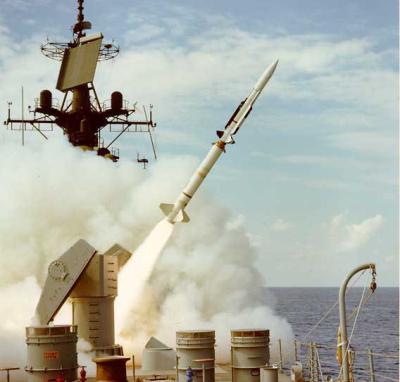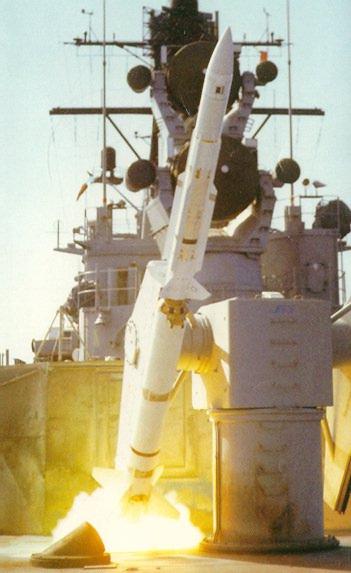Raytheon (General Dynamics) RIM-67 Standard ER
The Standard missile program was initiated in 1963 to provide a replacement for the RIM-2 Terrier and RIM-24 Tartar missile systems. The Tartar replacement was designated RIM-66 Standard MR (Medium Range), while the longer-range Terrier replacement became the RIM-67 Standard ER (Extended Range). The Standard is still the U.S. Navy's main medium and long range air defense missile.
All blocks of the Standard SM-1ER missile were designated as RIM-67A. They were essentially identical to the corresponding SM-1MR missile, except for the propulsion. Instead of the MR's MK-56 dual-thrust motor, the ER used an Atlantic Research Corp. MK 30 solid-fuel rocket sustainer motor, and a Hercules MK 12 booster.
 |
| Photo: U.S. Navy |
| RIM-67A |
The main improvements of the SM-2MR Block I/II/III missiles were also included in the corresponding SM-2ER versions, the major new features being the inertial guidance system, and the monopulse seeker for terminal homing. However, SM-2ER is not designed to be fired from Aegis ships. The SM-2ER Block I was designated RIM-67B, and entered service in 1980.
The RIM-67C SM-2ER Block II introduced a new MK 70 booster (regrained MK 12), which almost doubled the range of the SM-2ER. Interestingly, the enhanced booster extended the performance envelope of the RIM-67C well beyond the limits of the then current fire-control system on Terrier ships, but it did of course improve general missile performance against high-performance targets.
 |
| Photo: U.S. Navy |
| RIM-67C |
The RIM-67D SM-2ER Block III had a new model of the sustainer engine (MK 30 MOD 4), and an improved MK 45 MOD 8 TDD (Target Detecting Device).
The SM-2ER Block IV is a version with a completely new finless booster, designed for vertical launch on Aegis/VLS ships. Although this has been reported to be designated RIM-67E, the correct designation is RIM-156A, q.v.
In the 1980's the U.S. Navy planned a nuclear-armed version of the Standard SM-2ER, because the last nuclear armed surface-to-air missiles, the RIM-2D Terrier and RIM-8E/G/J Talos, were about to be retired, leaving the Navy without a nuclear anti-air warfare capability. The nuclear SM-2 was to be equipped with a W-81 fission warhead (4 kT yield). However, these plans have since been dropped, and the U.S. Navy has currently no nuclear-armed SAMs.
In 1995, Hughes (now Raytheon) proposed to convert obsolete RIM-2 Terrier missiles, of which more than 2000 were in storage, to supersonic low-altitude target (SLAT) configuration as a replacement of and/or successor to the MQM-8 Vandal. At 10 m altitude, range would have been 40 km (22 nm) with the MK 30 motor, or 64 km (35 nm) with the new MK 104 dual-thrust motor. As a ballistic missile target, maximum altitude and range could be 85 km (280000 ft) and 275 km (150 nm), respectively (168 km/550 km with MK 104 motor). The designation YRQM-67A was reserved for protoype conversions, but the Terrier conversion plan was eventually dropped. However, Raytheon has converted many surplus SM-2ER rounds (mostly RIM-67C) to TMT (Terrier Missile Target) configuration to serve as ballistic missile targets. Although I don't have firm evidence, these targets are probably designated RQM-67A.
Specifications
Note: Data given by several sources show slight variations. Figures given below may therefore be inaccurate!
Data for RIM-67A/C, except where noted:
| RIM-67A SM-1ER | RIM-67C SM-2ER | |
|---|---|---|
| Length (incl. booster) | 7.98 m (26 ft 2 in) | |
| Finspan | 1.07 m (42.3 in); booster: 1.57 m (62 in) | |
| Diameter | 0.34 m (13.5 in); booster: 0.45 m (18 in) | |
| Weight | 1340 kg (2960 lb) | |
| Speed | Mach 2.5 | Mach 3.5 |
| Ceiling | > 24400 m (80000 ft) | |
| Range | 65 km (35 nm) | 185 km (100 nm) |
| Propulsion | Atlantic Research Corp. MK 30 solid-rocket sustainer RIM-67A: Hercules MK 12 solid-rocket booster; RIM-67C: Hercules MK 70 solid-rocket booster | |
| Warhead | MK 51 continuous-rod | MK 115 blast-fragmentation |
Main Sources
[1] Norman Friedman: "US Naval Weapons", Conway Maritime Press, 1983
[2] Norman Friedman: "World Naval Weapons Systems, 1997/98", Naval Institute Press, 1997
[3] Bill Gunston: "The Illustrated Encyclopedia of Rockets and Missiles", Salamander Books Ltd, 1979
Back to Current Designations Of U.S. Unmanned Military Aerospace Vehicles
Back to Directory of U.S. Military Rockets and Missiles
Last Updated: 24 March 2004